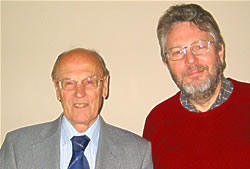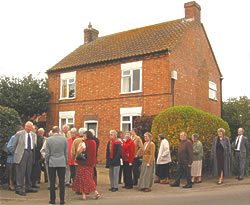Events and lectures, Spring 2006
The Annual General Meeting at Rolleston
 |
There was a sadness about this year's Annual General Meeting, with two major losses to the Society. Our President, Neville Hoskins, died on the last day of 2005 on what would have been his 80th birthday; and his predecessor as President, Myles Thoroton Hildyard, had died in August. Both these men had been long-standing, loyal members of the Society to whom much is owed, and there is much to celebrate about lives well lived and well remembered.
Members were pleased to elect as our new President Dr Rosalys Coope, an eminent architectural historian, who has clocked up over fifty years' association with the Society. Adrian Henstock, editor of Transactions, was elected as a Vice-President of the Society. The remaining Officers were re-elected without change, and we were pleased to confirm David Hoskins as a member of Council - keeping up the family association of service to the Society.
After the business of the meeting, our new President gave a fascinating glimpse of her entry into the world of Thoroton, back in the days when the male and mature were the leading lights of the Society - more about Rosalys on page 2 of the Newsletter. We then turned to the history of Rolleston, and were fortunate to be joined by Julian Ellis, a local resident and churchwarden of Holy Trinity Church, and by Frank Mitchell, who has lived in Rolleston all his life and has collected information and photographs of its history (pictured top right).
 |
Once again, members were provided with a very good tea in the brand new
village hall, a splendid and well appointed building achieved by a great
deal of voluntary local effort in raising money and accessing various funds.
It was good to witness a lively community in action: one with a sense of
its place in history, but still looking firmly to a vibrant rural future.
During tea, Steph Mastoris, visiting from Wales, was on hand to give a
preview of the next Record Series volume on the Welbeck maps. After tea
Julian and Frank took us on a tour of Rolleston, which included the site
of the old manor with its moat and stewponds, the remains of the cross
in the Millennium Garden, and the splendid church which is rich in carvings,
including the remnants of a Saxon cross. We also viewed the house (above,
left) at which Kate Greenaway stayed with her relatives on many occasions:
Rolleston and district was the inspiration for many of her drawings and
paintings. Many thanks to all those who made this another very enjoyable
and interesting AGM.
Barbara Cast
 |
11 March: The Maurice Barley Lecture: 'Vernacular stone in the buildings of Nottinghamshire' - Graham Lott, British Geological Survey, Keyworth
Using excellent images with PowerPoint and digital projection equipment,
Graham presented a subject not central to the knowledge of many members:
that of taking the quarries giving building stone in the county from west
to east, where they were located and when they were open, and giving examples
of buildings using the stone. This information has been brought together
by Graham in his BGS publication The Building Stone Resources of the UK.
With later buildings it was shown how a variety of different stones were
often used depending on load-bearing capabilities, freestone which broke
equally easily in any direction and was used for carving and sculpture,
the stone colour for decoration etc. Southwell Minster was built
of Mansfield White Magnesian limestone, this being the original choice
for the Houses of Parliament. Graham's examination of churches suggests
to him that the stone chosen for replacements was usually what the builder
had in his yard at the time, rather than what matched the original. We
were reminded of the excellent library of the BGS, open to the public by
prior appointment, and their book and gift shop selling everything geological
from hammers to semi-precious stones. At the end we dispersed with our
summer project set for us - to find the first Nottinghamshire example of
the use of Colleyweston slate.
Leslie Cram
 |
6 May: The Gardens of Robert and John Smythson at Wollaton Hall - Pete Smith
The group met to accompany Pete Smith on a tour of Robert and John Smythson's gardens. The morning had been lovely, but on the dot of 2.30pm the rain started to fall and continued throughout our tour, just stopping as the tour ended. This necessitated us moving from tree to tree for shelter whilst Pete explained the features we were looking at: but it did not in any way spoil our enjoyment of Pete's deep knowledge of the gardens.
Although Wollaton Hall is currently wrapped in scaffolding and sheeting whilst the extensive restoration work is being carried out, we could relate the garden features to the house, especially as Pete had thoughtfully provided copies of plans and pictures. The gardens we now see are, of course, nothing like those shown in the Smythson plans, the Ha-Ha did not feature in their layout, and
the stables, wash-house and brewery are long gone. A most interesting
aspect was the lower garden layout of what Pete called the 'house mound',
laid below the present terrace, and which could have been used for performances
with the audience standing on the terrace. The Camellia House had been
dismantled as part of the restoration work, but Pete gave us a word picture
of the building and its method of operation. He allowed us to gain a good
mental picture of how good the gardens would have appeared as planned by
the Smythsons, and the visit helped to contextualise his earlier talk to
the Society.
Howard Fisher